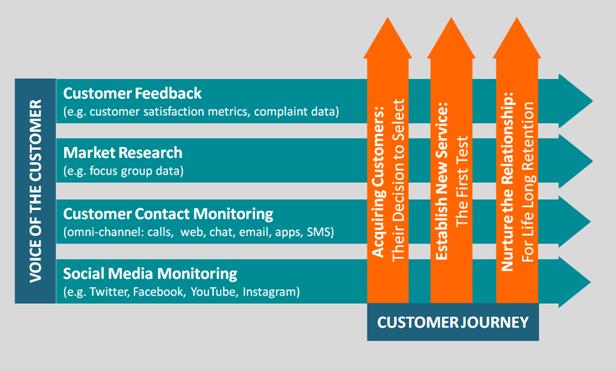Customer expectations have become increasingly more demanding. Customers have a shortage of time, but no shortage of choices. The stakes are high to win and retain customers, as well as ensure customers speak enthusiastically to others about the value received from their relationship with you.
Succeeding in the marketplace requires listening to the voice of your customers throughout the entire journey of that relationship. This is the essence of understanding the customer experience.
Customers speak to us with multiple voices and it is essential to have processes in place to capture those voices, assimilate the information and identify the customer insights that must influence everything from product development to operational delivery and back office support.
Let’s look at the four basic ways of listening to the customer’s voice:
- Customer Feedback. As a consumer, it is routine to receive a request for feedback subsequent to a transaction, whether it’s an airline flight, an online purchase, a call for support or even just a website visit. Those detailed surveys or more targeted satisfaction scores provide a snapshot of customer satisfaction and/or a willingness to promote you to others – at that given point in time. Customer feedback can also be found in internal operations data. Customer trouble tickets, outage reports, customer churn, product returns, and customer credit data are just a few examples of internal metrics that highlight the root causes of customer satisfaction.
- Market Research. There are unlimited news and independent third party perspectives regarding the customer experience for any given industry, and often specific businesses within an industry. Every enterprise needs to monitor their brand reputation to understand how consumers perceive them. Businesses can examine their own brand perception as well as that of their competitors, in order to update their customer service model and reflect what’s working best within a particular industry.
- Customer Contact Monitoring. There are a variety of channels from which a customer can contact an enterprise. Some customers call into a center; others prefer to self-serve through a website or mobile app, which then might lead to an online chat, an email request or a call for support. It is not uncommon for a customer to use multiple channels to solve a particular need. Across all these contact points a firm must listen to the voice of the customer to assess the effectiveness and efficiency of the interaction and to determine the customer’s emotional reaction to that contact. The business insights from these omni-channel contacts can provide specific, actionable ideas not only for enhancements to contact handling but also for business process improvements and product modifications.
- Social Media Monitoring. Enterprises can’t ignore Twitter, Facebook, Instagram, and other social networks. Listening and responding to social media is an opportunity to understand the customer voice on a different level. The content shared on social media is less predictable and certainly less controllable than other customer feedback mechanisms, as it can go viral quickly. As a growing channel, social media is an ever more important “voice” of customers and requires a plan for both monitoring and responding.

- Acquire Customers. Before selecting any service or product, a customer does their research. It’s important for customers to see that a business will meet their needs efficiently and be their best option in the marketplace. Product design, marketing, and sales are critical factors in this phase of the journey. Many customers regularly will do “web window shopping” before making a purchase decision, so the website is a critical channel in Acquiring New Customers.
- Establish a New Service. Once the customer is acquired, the business has an opportunity to delight a customer with the new product or service. Operational excellence is essential in the fulfillment and delivery of that initial purchase. First impressions count in creating a long term customer relationship. Customer experience is indelibly formed with a retail purchase or new service turn-up that is on-time, error-free and with an accurate bill. Be sure to listen to customer feedback as you Establish New Service. If you don’t get it right the first time, your chance for repeat purchases or continued services is significantly limited.
- Nurture the Relationship. There are two goals that a business should keep in mind when nurturing relationships. The first is to understand customers so well that the business can predict when and what their next purchase will be. The second is to create brand advocates through optimal customer experience. By reviewing purchasing history, studying customer habits and listening to the customer’s voice, companies can be proactive in communication efforts, create an excellent customer experience and cultivate lifelong relationships.
This chart illustrates the intersection of the voice of the customer across the end-to-end customer journey, which together creates a holistic customer experience.
The end-to-end customer journey spans multiple functions and requires cross-organizational processes and measures. It’s one thing to recognize the voice of the customer but another to leverage that information. Analyzing and acting on what customers are telling companies is a critical success factor. Once analytics are understood, it’s important to take business process management steps to understand how and what changes need to be made to processes to better serve the customer. This turns listening into the actions that create revenue growth and long-term customer retention.
Does your customer experience involve the end-to-end customer journey? Tell us about it here.







Amazing blog!! As you said customer expectations are increased over the past decades. All customers need outstanding customer engagement with the businesses. They want fast responses to their queries that’s why businesses need to opt digital omnichannel customer engagement platforms. This type of platform help to build a strong relationship with the customers.